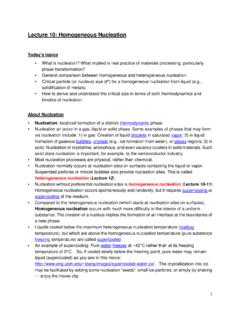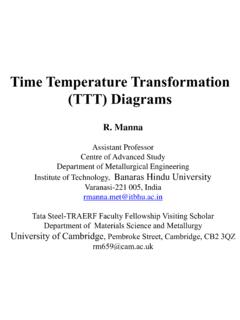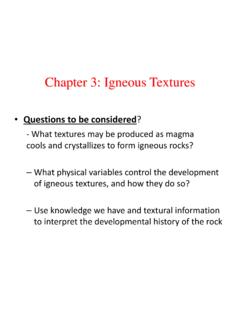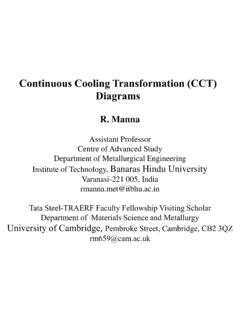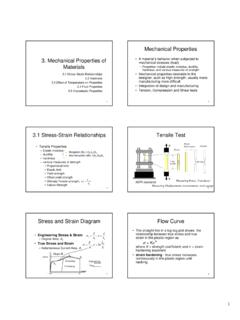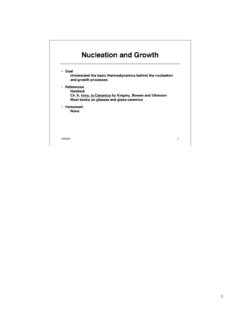Transcription of Nucleation and Growth - American University of Beirut
1 Nucleation and GrowthTopic DarwishMECH 636: Solidification Modelling5-4 Heterogeneous Nucleation ! undercooling of a few K sufficientNNheterogeneoushomogeneous> due to reduced nucleus/melt surfaceFig. 5-4. Sketch ofhomogeneous andheterogeneousnucleation. Thelatter occurs atexisting surfaces.""GfGccheterogeneoushomogeneous = ( )()ff=coscos:## wetting angleFig. 5-5. (Left) Nucleation at a wall and wetting angle #. (Right) f defined in eq. ( ) as function ofcos # for a flat substrate. As expected Nucleation is facilitated if the melt wets the solid Nucleation facilitated by:- similar crystal structure (low misfitstrain)- chemical affinity- rough surface (reduced melt/nucleus surface)Grafting of melt with small particles !
2 Fine the end of this lecture you should be able to:Explain the term homogeneous as applied to Nucleation eventsUnderstand the concept of critical size and critical free energyDifferentiate between unstable cluster (embryos) and stable nucleiDerive expressions for (r*,N, ..) in terms of Gv & typical heterogeneous Nucleation sites for solidificationUnderstand the term wetting or contact angle, Explain why the wetting angle is a measure of the efficiency of a particular Nucleation siteWrite an expression relating critical volumes of heterogeneous and homogeneous Solidification the atomic arrangement changes from a random or short-range order to a long range order or crystal structure. Nucleation occurs when a small nucleus begins to form in the liquid, the nuclei then grows as atoms from the liquid are attached to crucial point is to understand it as a balance between the free energy available from the driving force, and the energy consumed in forming new interface.
3 Once the rate of change of free energy becomes negative, then an embryo can Of Fusion Tm= HV S =hmV s S S=hmV sTm GV=hmV s ThmV sTm =hmV s1 TTm GV=GL GS= HV T SGTemperatureStable solidStable liquidsolidliquidTmGS!GGLT!T HV=LV =V s hm =LV TTm =V s hm TTmHomogeneous Nucleation1. When r is smaller than some r* an increase in r leads to an increase of G -> unstable2. When r is larger than some r* an increase in r leads to a decrease of G -> stable G=G2 G1 =VSGVS GVL()+ASL SL = VS GV+ASL SL GV=LV TTmLiquidG1 LiquidSolidG2 = G1 + !G ASL=4 r2 VS=43 r3 SL G1=VS+VL()GVL G2=VSGVS+VLGVL+ASL SL-ve+ve G= 43 r3 GV+4 r2 SLCritical radiusDifferentiate to find the stationary point (at which the rate of change of free energy turns negative).
4 D G()dr=0 4 r ()2 GV+8 r =0 From this we find the critical radius and critical free energy.!Gr0interfacial energy ! r2r*!G*!GrVolume free-energy !r3"TNot at G=0!!! r =2 SL GV =2 SLTmLV 1 T G =16 SL33 GV2 =16 SL3Tm23LV2 1 T()2 G= 43 r3 GV+4 r2 SLif r<r* the system can lower its free energy by dissolution of the solidUnstable solid particles with r<r* are known as clusters or embryosif r>r* the free energy of the system decreases if the solid growsStable solid particles with r>r* are referred to as nucleiSince G = 0 when r = r* the critical nuclei is effectively in (unstable) equilibrium with the surrounding liquidCluster and Nuclei!Gr0interfacial energy ! r2r*!G*!GrVolume free-energy !
5 R3"TGTemperatureStable solidStable liquidsolidliquidTmGS!GGLT!T! 2"SLr1#At r* the solid sphere is at equilibrium with its surrounding thus the solid sphere and the liquid have the same free energy! 2"SLr2#! r2">r1"Effect of UndercoolingHow r* and G* decrease with undercooling T GV=2 SLr !Gr0interfacial energy ! r2r*!G*!GrVolume free-energy !r3"TNuclei are stable in this regionEmbryos form in this region and may redissolveCritical radius of particle, r* (cm) !T, C 4 r ()2 GV+8 r =0 Variation of r* and rmax with T Although we now know the critical values for an embryo to become a nucleus, we do not know the rate at which nuclei will appear in a real system. To estimate the Nucleation rate we need to know the population density of embryos of the critical size and the rate at which such embryos are formed.
6 The population (concentration) of critical embryos is given by nr=noe GrkTk is the Boltzmann factor, no is the total number of atoms in the system Gr is the excess of free energy associated with the cluster!T0rr*!TNrmaxHomogeneous Nucleation Rate C =Coe Ghom kTclusters/m3taking a G equal to G*, then the concentration of clusters to reach the critical size can be written as:The addition of one more atom to each of these clusters would convert them into stable nucleiIf this happens with a frequency fo, Nhom=foCoe Ghom kTnuclei/m3 Nhom=foCoe A T()2nuclei/m3 A=16 SL3Tm23LV2kT!T0rr*!TNrmaxThe effect of undercooling on the Nucleation rate is drastic, because of the non-linear relation between the two quantities as is shown in the plot!
7 TN!TNhomHeterogeneous Nucleation G =16 SL33 GV2 =16 SL3Tm23LV2 1 T()2it is clear that for Nucleation to be facilitated the interfacial energy term should be reduced ML= SM+ SLcos cos = ML SM() SLSolidNucleating agent! "SM! "SL! "MLLiquid! "Heterogeneous Nucleation G1=VS+VL()GVL+ A ML+AML() ML G2=VSGVS+VLGVL+ A ML ML+ASL SL+ASM SM G=G2 G1= VS GV+ASL SL+ASM SM AML ML Ghet= 43 r3 Gv+4 SL S ()Nucleating agent! "SM! "MLLiquidSolidNucleating agent! "SM! "SL! "MLLiquid! " S ()=2+cos ()1 cos ()24<1 GhomCritical r and G r =2 SL GV G =16 SL33 GV2S ()!Gr0!Grr*!Gr! "Ghet#! "Ghom#!TNhomNhetN!G*!T! "Ghom#! "Ghet#Critical value for Nucleation =10 S ()=10 4 =30 S ()= does not work for =0 Heterogeneous Nucleation Rate Nhet=f1C1e Ghet kTnuclei/m3 n =n1e Ghet kTnumber of atoms in contact with nucleating agent surfacenumber of atoms in contact with nucleating agent surface per unit volumeMould walls not flat G =12V GvExercise show thatCritical radius for solidfor cracks to be effective the crack opening should be large enough to allow the solid to grow out without the radius of the solid/liquid interface decreasing below r* Nucleation in cracks occur with very little undercoolingNucleation of MeltingWhile Nucleation during solidification requires some undercooling.
8 Melting invariably occurs at the equilibrium temperature even at relatively high rates of is due to the relative free energies of the solid/vapour, solid/liquid and liquid/vapour is always found that SL+ LV< SVTherefore the wetting angle =0and no superheating is required for Nucleation of the liquidGrowth of a Pure SolidIn a pure metal solidification is controlled by the rate at which the latent heat of solidification can be conducted away from the solid/liquid kSdTSdx=kLdTLdx+vLVSolidLiquidSolidLiqui dxTDevelopment of Thermal Dendrites v kLdTLdx1LV kLLV Tcr dTLdx Tcr dTSdx 0 Tr=2 TmLVr r =2 TmLV Tr v kLLV1r1 r r r=2r TL,farTmTS!To!Tr!TcrxLiquidSolid kSdTSdx=kLdTLdx+vLVAlloy SolidificationTTL (cL)xLT1(co)T3(c1)TL(x)coc1cL(x)0xDL/vco nstitutionalundercoolingSolidLiquidcriti calgradientSolidLiquidkcococo/kTcmaxceut T1T2T3cScLk=cS/cLcABLimited Diffusion in Solid and Liquid5-7 Constitutional undercooling and solidification morphologyFig.
9 5-9. How con-stitutional under-cooling affectssolidification parameters: Local solidification rate:if low, solute has time to diffuse away from interface into bulk liquid ! planar Growth grad T:> critical value ! no constitutional undercooling(cf. Fig. 5-9).Steep grad T + low SL interface velocity!planar Growth ( Growth of Si single crystals)Planar Growth "cell Growth "dendrite Growth ###no undercoolingmoderate undercoolingstrong undercooling5-7 Constitutional undercooling and solidification morphologyFig. 5-9. How con-stitutional under-cooling affectssolidification parameters: Local solidification rate:if low, solute has time to diffuse away from interface into bulk liquid ! planar Growth grad T:> critical value !
10 No constitutional undercooling(cf. Fig. 5-9).Steep grad T + low SL interface velocity!planar Growth ( Growth of Si single crystals)Planar Growth "cell Growth "dendrite Growth ###no undercoolingmoderate undercoolingstrong undercoolingSummary By considering the balance between the release of free energy by transformation and the cost of creating new interface, the critical free energy for Nucleation and the critical size of the nucleus can be derived. The exponential dependence of Nucleation rate on undercooling means that, in effect, no Nucleation will be observed until a minimum undercooling is achieved. The undercooling required for Nucleation is increased by volume changes on transformation, but decreased by the availability of heterogeneous Nucleation Consider the units of the various quantities that we have examined.


![Sir Francis Bacon, Novum Organum [1620]](/cache/preview/0/d/5/d/8/d/7/8/thumb-0d5d8d7878eeee001579639a14b1fcc6.jpg)


